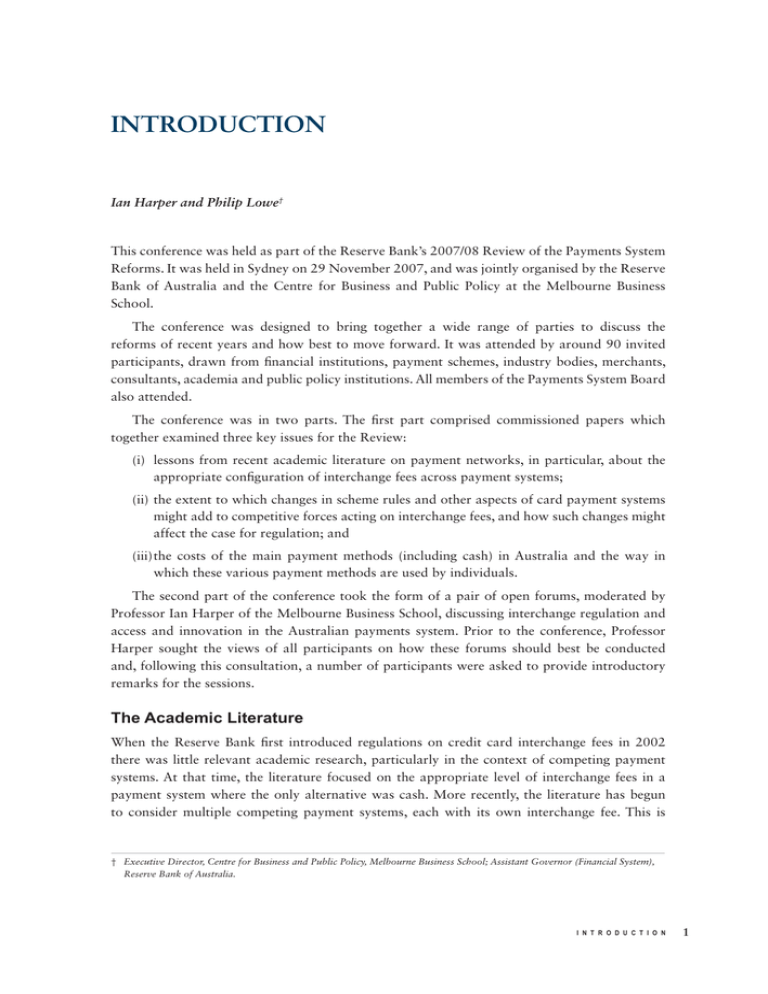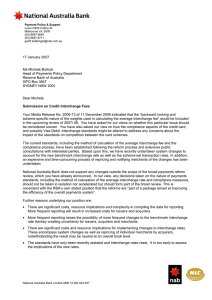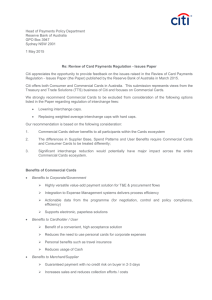INTRODUCTION
advertisement

INTRODUCTION Ian Harper and Philip Lowe† This conference was held as part of the Reserve Bank’s 2007/08 Review of the Payments System Reforms. It was held in Sydney on 29 November 2007, and was jointly organised by the Reserve Bank of Australia and the Centre for Business and Public Policy at the Melbourne Business School. The conference was designed to bring together a wide range of parties to discuss the reforms of recent years and how best to move forward. It was attended by around 90 invited participants, drawn from financial institutions, payment schemes, industry bodies, merchants, consultants, academia and public policy institutions. All members of the Payments System Board also attended. The conference was in two parts. The first part comprised commissioned papers which together examined three key issues for the Review: (i) lessons from recent academic literature on payment networks, in particular, about the appropriate configuration of interchange fees across payment systems; (ii) the extent to which changes in scheme rules and other aspects of card payment systems might add to competitive forces acting on interchange fees, and how such changes might affect the case for regulation; and (iii) the costs of the main payment methods (including cash) in Australia and the way in which these various payment methods are used by individuals. The second part of the conference took the form of a pair of open forums, moderated by Professor Ian Harper of the Melbourne Business School, discussing interchange regulation and access and innovation in the Australian payments system. Prior to the conference, Professor Harper sought the views of all participants on how these forums should best be conducted and, following this consultation, a number of participants were asked to provide introductory remarks for the sessions. The Academic Literature When the Reserve Bank first introduced regulations on credit card interchange fees in 2002 there was little relevant academic research, particularly in the context of competing payment systems. At that time, the literature focused on the appropriate level of interchange fees in a payment system where the only alternative was cash. More recently, the literature has begun to consider multiple competing payment systems, each with its own interchange fee. This is † Executive Director, Centre for Business and Public Policy, Melbourne Business School; Assistant Governor (Financial System), Reserve Bank of Australia. I N T R O D U C T I O N 1 more relevant to the policy issues facing the Reserve Bank, particularly given the substantially different interchange fees in the credit card and EFTPOS systems in Australia. Professor Jean-Charles Rochet of Toulouse University was invited to summarise the main findings of this recent literature. His paper notes that the academic work dealing with multiple competing payment systems is still in its infancy and faces a number of challenges. The conditions characterising efficient use of various payment methods are complex and multiple distortions exist in the payments system. Nevertheless, Professor Rochet’s paper suggests a number of tentative policy-relevant conclusions. These include: (i) that there are solid theoretical grounds why a pricing structure in which merchants bear more of the costs of payments than do consumers might be socially optimal; (ii) that card schemes and banks may have an interest in inflating credit card interchange fees, given that issuers’ profits appear to increase as interchange fees rise; (iii) that interchange fees may be needed not only in developing payment systems but also in mature systems; and (iv) that there may be a case for capping the difference between credit and debit card interchange fees to discourage overuse of credit cards by individuals not seeking credit. Alternatives to Interchange Regulation – Removing Restrictions on Merchants One issue facing the Reserve Bank is whether there are alternatives to interchange regulation as a means of achieving its objectives. A number of industry participants have argued that the regulation of interchange fees is unnecessary, provided other aspects of the payments system are addressed, including the removal of various restrictions on merchants and improved transparency. As part of its reforms, the Reserve Bank has sought to promote soundly based competition by requiring credit card schemes to remove their no-surcharge rules and to modify their ‘honour all cards’ rules, and requiring the publication of interchange fees. At issue is the extent to which these changes have heightened competition, and whether further changes in the same direction might serve as an alternative to regulating interchange fees. Dr Alan Frankel of Lexecon was invited to examine the case for interchange regulation and, in particular, whether other changes in the payments system might promote competition and reduce the need for regulation. He concludes that mandatory interchange fees should be eliminated and replaced by a system in which such fees are set through mutually voluntary contracts. The paper also discusses a variety of restrictions that payment systems can place on merchants (and other participants in the payment system) that effectively limit competition. In addition to the restrictions previously identified by the Reserve Bank, the paper discusses the possibility of a significant change in the structure of the industry that would allow merchants, rather than cardholders, to choose the network over which a payment is processed. Such a structure has the potential to significantly change the nature of the competitive forces acting on payment schemes. Costs and Payment Patterns A major consideration in the Reserve Bank’s original decision to regulate credit card interchange fees was that for many cardholders the effective marginal price of a credit card transaction was 2 R E S E R V E B A N K O F A U S T R A L I A much less than the effective price of an EFTPOS transaction, despite the EFTPOS system having lower underlying resource costs. As part of the Review, both the Reserve Bank and a number of industry participants considered it important that the differences in costs between the two systems be re-examined. In addition, given the wide ranging nature of the Review, it was also thought appropriate to examine the costs associated with a range of other payment methods, most importantly cash. Another consideration in the Reserve Bank’s original decision was the assessment that, in many situations, credit and debit cards are close substitutes for one another and that, as a result, price signals to consumers could have a significant influence on payment patterns. It has also been noted that for many payments, cash is a ready substitute for card-based payments. Given the limited existing information on how various payment methods are used, the Reserve Bank, as a further input into the Review, undertook an extensive study of how individuals make their payments. The results of both these studies were presented and discussed at the conference. The key findings are: • the aggregate costs incurred by merchants and financial institutions for payments made by individuals amount to at least 0.8 per cent of GDP; • cash appears to be the lowest cost payment instrument for the small transaction sizes for which it is typically used; • the resource costs involved in credit card transactions are significantly higher than for EFTPOS transactions, even after excluding those costs associated with the credit function. This is due primarily to costs incurred by issuers of credit cards (associated with fraud and fraud prevention, and with operating an international scheme); • cash is the most widely used payment instrument in Australia, accounting for around 70 per cent of transactions made by individuals; and • cards are the main payment method for transactions between around $50 and $500, with credit card use increasing relative to debit card use as the size of payments increases. The Reforms – Possible Ways Forward The first of the open forums was devoted to interchange fees. The discussion was introduced by Leigh Clapham of MasterCard, Paul Rickard of the Commonwealth Bank, and Douglas Swansson of Coles Group. The discussion was wide ranging, with a variety of perspectives presented. Some saw a strong case for continued regulation of interchange fees, arguing that the reforms have delivered gains in competition and efficiency and that these would be lost if regulation was abandoned. Some went further arguing that interchange fees in all payment systems should be abolished, and that cardholders should not be ‘subsidised’ by merchants (through interchange fees) when using various payment methods. An alternative perspective was that interchange regulation could be removed given that the competitive environment has changed in recent years, owing to increased transparency and the removal of various restrictions on merchants. It was also argued that the case for allowing the international card schemes to once again set I N T R O D U C T I O N 3 interchange fees would be strengthened by the development of an EFTPOS scheme (to replace the existing bilateral arrangements) and the establishment of a transparent methodology by industry for the setting of interchange fees. Other participants, however, questioned the practicality of the industry agreeing upon a methodology and no concrete proposals were offered. Finally, another perspective was that the regulation of interchange fees has not met its objectives and should be unwound. Participants expounding this view argued that the reforms have simply resulted in a transfer from cardholders to merchants and that merchants are using their increased power to exploit customers through high surcharges. Furthermore, it was argued that there has been no change in payment patterns resulting from the reforms. The second open forum was devoted to access and innovation in Australia’s payments system. The discussion was opened by Geoff Bebbington of National Australia Bank and Manuel Garcia of Indue. Once again the discussion was broad ranging, with widely divergent views expressed as to the best way forward and the role of the Reserve Bank. Some argued that the Bank’s regulatory intervention in card markets has created uncertainty about the returns from investment, thereby inhibiting innovation. In particular, the Bank’s credit card interchange fee reductions were claimed to have delayed or prevented desirable innovations by reducing the revenue stream to issuing institutions. Others, however, suggested that lower interchange fees may promote innovation if the bulk of required investment is on the acquiring side, and disputed that the Bank’s regulatory actions had been responsible for any reduction in investment in Australia’s credit card or EFTPOS systems. It was also argued that new (and especially small) institutions are often the primary source of innovation in networks and that, by improving access to Australia’s card payment systems, the Reserve Bank has enhanced the prospects for development of new products in these systems. Some countered this view by suggesting that the Bank’s access reforms have had little practical effect. Others, however, stated that these reforms have been important to their own institutions, and that any stepping back from the full suite of regulations by the Bank would undermine their capacity to compete. Summary The conference generated a lively and useful discussion of many of the key issues for the Reserve Bank’s Review of the Payments System Reforms. Although widely divergent views continued to be expressed about the appropriate regulatory role for the Reserve Bank, the debate informed ongoing deliberations of the Payments System Board about the way forward. Both the Reserve Bank and the Melbourne Business School would like to thank all those who assisted with the planning and running of the conference and those who participated, especially those who prepared the papers reproduced in this volume. 4 R E S E R V E B A N K O F A U S T R A L I A


